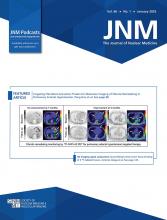Visual Abstract
Abstract
Prostate-specific membrane antigen (PSMA)–targeted radioguided surgery (RGS) is evolving as a new treatment modality for patients with early biochemical recurrence of prostate cancer and disease limited to locoregional lymph nodes on PSMA-ligand PET/CT. Nevertheless, the pattern of failure (locoregional vs. systemic) after PSMA RGS remains unknown. Therefore, the aim of this retrospective analysis was to evaluate the pattern of disease using PSMA-ligand PET in patients experiencing relapse after PSMA RGS. Methods: We evaluated 100 patients with biochemical recurrence after previous PET-guided PSMA RGS who underwent PSMA-ligand PET (median prostate-specific antigen [PSA], 0.9 ng/mL; range, 0.2–14.2 ng/mL). All suspicious lesions for recurrent prostate cancer were grouped according to the molecular imaging TNM classification system. Detection rates and lesion localization were determined and stratified by PSA values and the International Society of Urological Pathology grade group. Further, lesion localization was compared before and after PSMA RGS. Results: The median time between PSMA RGS and PSMA-ligand PET for relapse was 11.4 mo (range, 5.5–25.6 mo). In total, 91 of 100 (91%) patients showed PSMA-ligand–positive findings. PSMA PET detection rates were 82.6%, 92.6%, 91.3%, and 96.3% for PSA levels of 0.2–0.49, 0.5–0.99, 1–1.99, and at least 2 ng/mL, respectively. More than half of the patients (53%; 48/91) showed local recurrence or pelvic lymph node metastases only. Extrapelvic lymph node metastases, bone metastases, and visceral metastases were present in 22% (20/91), 16% (15/91), and 9% (8/91) of the patients, respectively. With increasing International Society of Urological Pathology grade group, the percentage of patients with bone and visceral metastases increased, whereas the number of patients with only locoregional disease decreased. Conclusion: PSMA-ligand PET is a useful method to detect and localize recurrent disease in patients with biochemical failure after PSMA RGS, with more than half of the patients presenting with locoregional recurrence, offering the potential for a second local therapy (e.g., radiation therapy or repeated surgery).
Footnotes
Published online Sep. 26, 2024.
- © 2025 by the Society of Nuclear Medicine and Molecular Imaging.
This article requires a subscription to view the full text. If you have a subscription you may use the login form below to view the article. Access to this article can also be purchased.
SNMMI members
Login to the site using your SNMMI member credentials
Individuals
Login as an individual user








